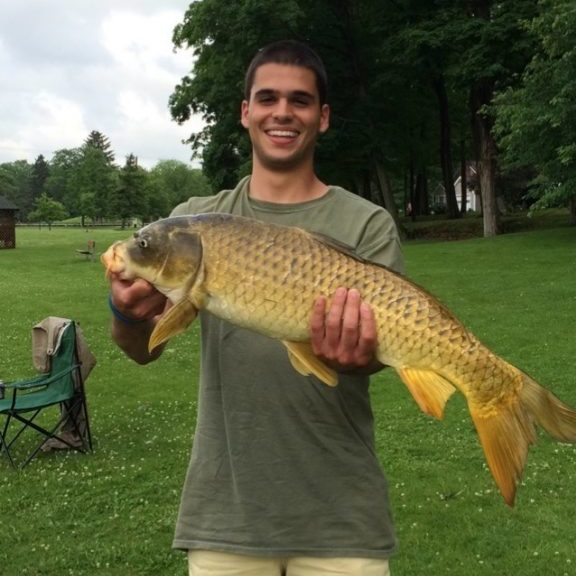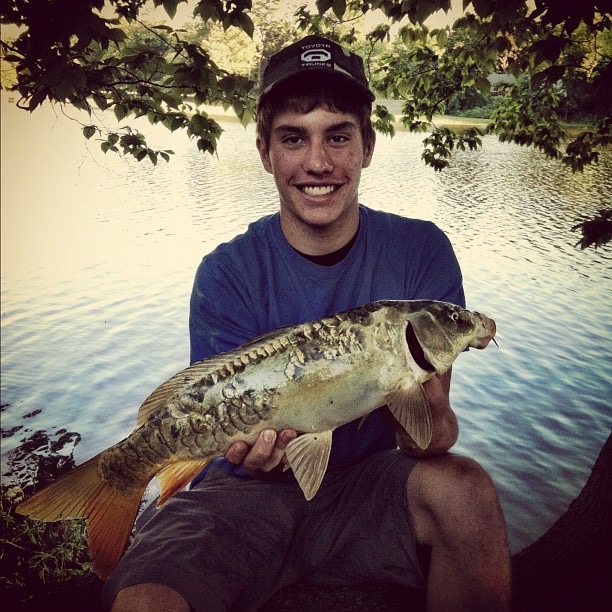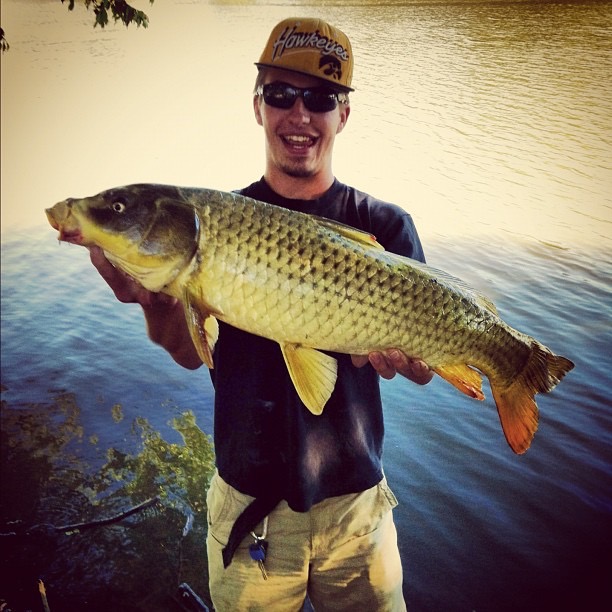The Common Carp
The common carp, (Cyprinus carpio), is a warm-water fish found throughout western New York. Common carp generally range between 20 and 30 inches in length and can be identified by their broad, golden body, barbels, and extendable mouth.
There are two types of common carp found in western New York: the common carp and the mirror carp. Although they differ in appearance, common and mirror carp are the same species, Cyprinus carpio. The aesthetic difference between common and mirror carp is obvious. Common carp only have small, regularly sized and spaced scales, while the mirror carp has many areas of very large scales and are smooth elsewhere. Pictured below are a common carp (top) and mirror carp (bottom) for comparison.


Habitat
Common carp are warm-water fish and are extremely tolerant of warm water temperatures. Carp can also survive in lakes and ponds that are choked with weeds. Common carp can be found in many places, including large ponds, lakes, and warm-water creeks and rivers. The only place where carp might be hard to come by is cold, clean, well-oxygenated wild trout streams.
In lakes and ponds, carp are usually found closer to shore, cruising weedy areas and feeding, often in schools. In creeks and rivers, carp can be found not only in deep, sluggish sections, but also in relatively shallow sections that are only knee-high. Carp prefer to avoid swift water in creeks and rivers.
Food
A common carp’s diet consists of a mix of aquatic plants and insects. Common carp can sometimes be seen eating algae or other weeds in the shallows. Common carp also scavenge the bottom of lakes of creeks, especially areas with a muck bottom, probably looking for worms or other bugs. Interestingly, common carp can often be seen feeding in schools. The telltale sign of carp feeding is an isolated area of mud kicked up that contrasts the general water clarity. These so called “feeding clouds” occur when carp are nosing through the mud on the lakebed looking for insects or other food. Often, feeding carps’ tails will break the surface of the water, which is another sign to look for when targeting common carp.
Where to Catch Common Carp
Common carp are pretty prevalent in western New York and can be found in all counties. Common carp, and also grass carp, will often be stocked in ponds and lakes to control weed populations. Therefore, the first place to look for common carp should be ponds and lakes in neighborhoods and public parks. Common carp are also found in the slow moving sections large area creeks. Common carp can be found in creeks such as 18 Mile (Erie), Cattaraugus, and Buffalo creeks. Common carp are likely present in all major creeks and lakes in western New York.
Spring and summer are the best times to target common carp. In May and June, common carp can often be seen jumping out of the water in lakes and ponds, especially in the evening. Common carp seem to bite best on calm, warm, sunny days. Midday is usually a good time to target carp, but they can be taken all day and even at night. Night fishing for common carp is possible but is generally not as productive as fishing during the day. Below is a nice common carp caught at a local lake on canned corn.

How to Catch Common Carp
Because of their feeding habits, the best way to target common carp is bait fishing. The best bait for carp is probably whole canned corn. Boilies are also popular for carp fishing, especially in the U.K. Boilies are balls of dough infused with corn or other flavor that are placed on a boilie rig. Boilies can be made easily at home, but boilie rigs require more effort than using canned corn. From experience, there does not appear to be an advantage to using boilies over canned corn or vice-versa.
A good rig to use when fishing for common carp is 3-4 pieces of canned corn on a hook with a small weight added about a foot up the line. When fishing ponds or lakes, cast your rig out, reel in the slack, and wait. It is good practice to wait 30-40 minutes before checking your bait. Rod holders are also a good idea because carp fishing is a waiting game. Make sure you try casting lines both shallow and deep to cover as much water as possible. Carp will sometimes strike bait casted no more than 4 or 5 feet from shore.
Common carp can also be caught on the fly and although not very popular in western New York, fly fishing for carp is popular in other areas of the country and especially in Europe. Hooking into a 7 or 8 pound common carp on the fly can be an exhilarating experience as they are hard fighting fish and can quickly have you into your backing. Dry flies are a good bet if you notice carp slurping flies off the surface. In addition, flies with an algae-like aesthetic or even nymphs often work well in ponds. When targeting carp with wet flies (algae flies or nymphs), do your best to strategically place the fly in the carp’s feeding path. Carp will seldom go out of their way to take a fly.
